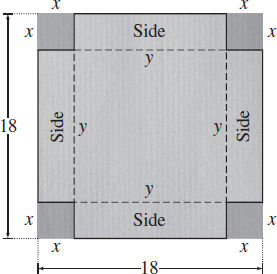EXAMPLE 2Maximizing a Volume
From each corner of a square piece of sheet metal 18 cm on a side, we remove a small square and turn up the edges to form an open box. What are the dimensions of the box with the largest volume?
Solution
Step 1 The quantity to be maximized is the volume of the box; we denote it by V. We denote the length of each side of the small squares by x and the length of each side after the small squares are removed by y, as shown in Figure 54. Both x and y are in centimeters.
320

Step 2 Then y=(18−2x) cm. The height of the box is x cm, and the area of the base of the box is y2 cm2. So, the volume of the box is V=xy2 cm3.
Step 3 To express V as a function of one variable, we substitute y=18−2x into the formula for V. Then the function to be maximized is V=V(x)=x(18−2x)2
Since both x≥0 and 18−2x≥0, we find x≤9, meaning the domain of V is the closed interval [0,9]. (All other numbers make no physical sense—do you see why?)
Step 4 To find the value of x that maximizes V, we differentiate V and find the critical numbers: V′(x)=2x(18−2x)(−2)+(18−2x)2=(18−2x)(18−6x)
Now, we solve V′(x)=0 for x. The solutions are x=9orx=3
The only critical number in the open interval (0,9) is 3. We evaluate V at 3 and at the endpoints 0 and 9. V(0)=0V(3)=3(18−6)2=432V(9)=0
The maximum volume is 432 cm3. The box with the maximum volume has a height of 3 cm. Since y=18−2(3)=12 cm, the base of the box measures 12 cm by 12 cm.